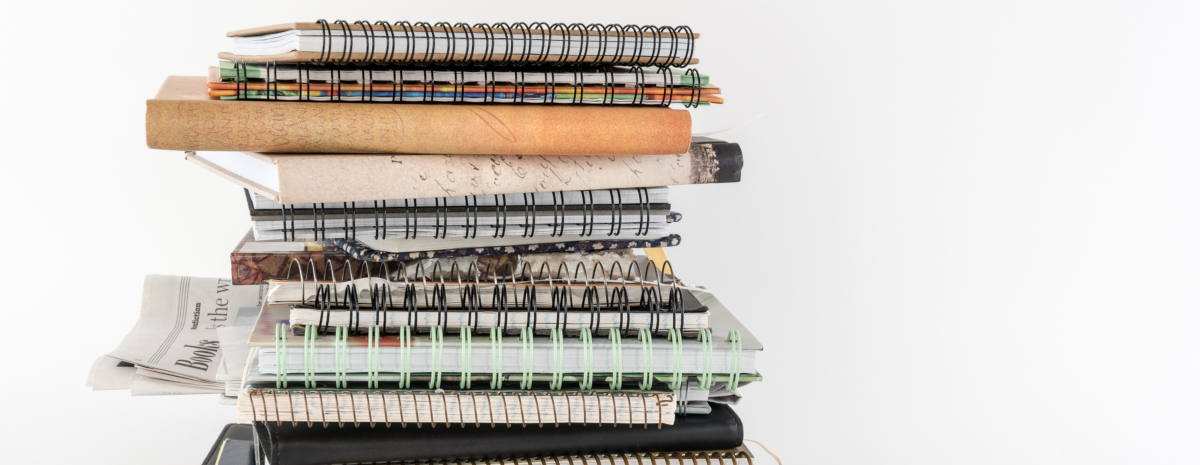When you think about a journal-writing practice, what comes to mind? Is it a specific format or style? Do you imagine the pages looking a certain way and containing certain things? Perhaps you have only a vague concept of what a journaling practice might look like.
In fact, there are several types of journal writing styles. Some people choose one and others have more than one journal on the go at a time. Here’s a breakdown of our Top-11 favourite styles of journal—we hope you’ll get new ideas from the list, or even create your own.
1) Gratitude Journal
Recording the things you’re grateful for is the purpose of a gratitude journal. It’s like “counting your blessings” in writing. The concept of gratitude journaling is to write at least one thing a day you’re grateful for—even on the tough days when everything seems to go wrong.
We can vouch for this approach and so can research, which shows that a regular practice of gratitude literally changes the brain (in positive ways).
Check out our blank journal books for support with your gratitude journal practice. Our January Prompted Journal includes a special spot for gratitude each day.
2) Morning Pages Journal
Start your morning pages practice
Created by author Julia Cameron, the morning pages journal is three pages of longhand free-writing every morning. This stream-of-consciousness approach to journaling has also been shown to have several benefits, which we wrote about at greater length in our morning pages journal blog article.
Check out our morning pages blank journals for support.
3) One Line a Day Journal
As simple as it sounds! Use a one-line-a-day (OLAD) journal to record one sentence every day—it could be about a key experience, a feeling, or a theme for the day. It’s an effective way to both reflect on a day and summarize it into a statement that expresses the most notable thing for you in the moment.
I keep an OLAD journal along with a diary and use the OLAD as a quick-reference index for when I want to refer back to old diaries.
4) Bullet Journal
The bullet journal is known as “an analog method for the digital age”. It’s actually a whole method of journaling that tracks what’s happened (past), organizes what is happening (present), and gives intention to the future (design).
Learn more at the bullet journal website.
5) Affirmations Journal
An affirmation is a positive statement in the present tense that expresses a state of being. The trick with an affirmation is to state a desired goal or outcome as if it is already occurring. The affirmations practice is based on widely acknowledged science and is a tool used by sports stars and other high-achieving folks in all realms.
In an affirmations journaling practice, the writer creates and records daily affirmations. You can repeat one affirmation for several days/weeks/months, you can allow an initial affirmation to evolve over time, or you can write a new affirmation each day.
Check out our blank journal books for a great place to conduct an affirmation journal practice.
6) Dream Journal
Many people record their dreams. Tracking dreams can be enlightening and interesting, as you discover recurring themes or images over time. A dream journal practice builds awareness of the subconscious thoughts and trends.
You’ll need to keep a journal at your bedside, and you must record the dream as soon as you have it. For many people, it’s difficult to wake up to do that. One trick to improve the odds is to drink a big glass of water right before bed.
Consider one of our blank journal books to record your dreams in a journal.
7) Vision Journal
Start a vision journal
Business and life coaches often recommend vision boards or vision journals as a way to stay focused on the “big picture”—the end goal you’re trying to achieve. That could be a certain kind of life, business, project, career, and so on. The idea is to record the vision, associated goals, and specific steps to get there.
If you’re a visual person, one of our sketchbooks or workbooks may support your vision journal practice. If you’re a word person, a blank-lined journal book is the way to go—one of our humour and novelty covers might be fun to try.
8) Travel Journal
Even people who don’t regularly keep journals often do keep journals of their travels. It’s a powerful way of capturing moments, experiences, memories, conversations, and emotions that happen during travel and which may never happen again in the course of regular life.
Travel journals are also places to record names and addresses of accommodations, restaurants, and people you may want to return to in the future, or recommend to others. Travel journals are often stuffed full of mementos, too—keepsakes like tickets, brochures, news clippings, and menus.
Keeping a travel journal also supports you if you want to make a more elaborate scrapbook or photobook of the trip after you’re home. One of our sketchbooks or workbooks are perfect to accommodate the whole range of content that a travel journal may include.
9) Epistolary Journal
Many people who feel blocked about writing a journal have no problem writing for pages when they imagine that they are addressing it to someone specific. Also known as a letter journal, this style of journal contains entries like letters.
An epistolary journal can be addressed to one person, or different people each day. You can write “to” your past self, future self, a family member or friend, people alive or past, an imaginary friend, or a real person you’ve never met. These letters are rarely if ever sent but having a specific person to write to can anchor one’s thoughts and emotions.
Consider one of our blank journal books for your letter journal.
10) Diary Journal
A diary is sometimes called “deep journaling” or a “thought journal”. It’s like writing morning pages (see above) without the constraints of three pages or writing in the morning.
In a diary, you can write absolutely anything in any style or any mix of styles. It’s free-form and is perfect for capturing random thoughts, emotions, ideas, experiences, events, questions, visions, dreams, and more.
Any of our blank journal books, sketchbooks, and workbooks will support a diary practice.
11) Project Journal
Blank lined journal books
Possibly the most focused of our Top-11 journal writing styles, the project journal is dedicated to a single, usually temporary activity, such as a work project, hobby, or renovation project. For example, I keep a project journal for each large writing project. Crafters often keep track of their designs, materials, costs, and method notes in journals.
A project journal is useful for capturing the evolution of a project from initial conception through completion. It can also be used to record meeting notes, contact information, reference resources, and conversations related to the project.
Consider one of our blank journal books, sketchbooks, or workbooks to support your project journal.


